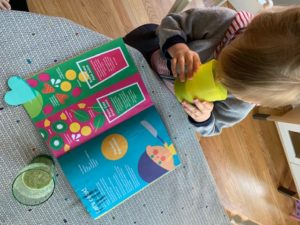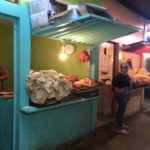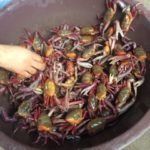El Plato Tipico
These days, I have food on the brain. This is a post about el plato tipico de Honduras (the typical dish) and my musings on cooking and nourishment during this period of quarantine.
Fresh Ingredients
When we lived in Honduras, shopping at the local Mayoreo market was a delicious weekly ritual. I selected fresh locally sourced exotic fruits: pineapples, bananas, avocados, coconuts, mangoes and passionfruit at the open air market. It was fun and delicious. Click here to read my description of the fruit and vegetable sections.
I never completed my visual description of the meat and seafood sections of the market. The quality control measures in the meat, fish and dairy sections of the market are a bit different to what I was used to. Those with weak stomachs should abstain from reading this paragraph. The strong smell of seafood and rotting meat forced me to hold my breath as I ventured down the dark stuffy alleyway to the fishmongers. Gingerly, I walked by the hanging carcasses of beef as the smiling vendors gestured proudly to the piles of long purple cow tongues, fleshy beige tripe (intestines), and bloody chicken feet. Annoyed, I swatted at the flies buzzing noisily around my head. I tread carefully of the slippery floor trying to avoid bloody patches. I dodge the live crab desperately trying to escape from his bucket. The lobsters snapped lazily at me from their beds of ice. Curious, I peered at some small grey round rubber balls in a purple bowl. I asked the vendor what they were. He was evasive and appeared reticent to want to make a sale. Only later did I realize that these were illegal turtle eggs. I never bought any red meat from the market. I was too afraid of getting sick (read about out worm experience here.) But I did buy fresh fish which was filleted and prepared on the spot for me. I also found huge fresh jumbo shrimp which were inexpensive and delicious. The eerie experience of walking down the meat aisle made up for the delicious home cooked food.
Reinvented Recipes
The novelty of the vibrant colors, strong smells and new tastes of the exotic fruit and vegetables wore off. I yearned for the comfort of a gooey mac and cheese, a crunchy apple, or the perfect tofu stir fry from home. A Canadian baker friend suggested I recreate my cravings from scratch. I searched online for recipes and then cooked up new dishes using local ingredients. I replaced my craving for apple pie with passion-fruit cake. Instead of soft drinks I drank delicious fresh pressed watermelon juice. An added benefit was these new cravings only cost a fraction of the price of the processed imported North American junk food. See that yummy avocado toast on Pinterest? Well, I could have one every day of the week and it was cheaper than a bowl of corn flakes.

El Plato Tipico
Most lower income Hondurans eat rice and beans for breakfast, beans and rice for lunch and “gallo pinto” for dinner. What is gallo pinto you ask? It’s a mixture of rice and beans with fresh cilantro. The typical meal in Honduras (and most of Central America) is called Plato Tipico. The staple meal consists of rice and beans, chismol, scrambled eggs, fresh avocado, fried plantain and a slice of salty homemade cheese. Keep reading for more details on the different ingredients.

The meal covers all four food groups. Chismol (called pico de gallo in other Latin American countries) is made with fresh tomato, onion, coriander and lime juice mixed into a salad. Click here for the recepie for chismol. Simple scrambled eggs and slightly salted avocado slices stand in for protein. Platanos maduros (fried sweet plantain) are mushy and taste slightly sweet and oily. You will need very large ripe plantain bananas which are then peeled, sliced lengthwise and then cooked in hot oil. Click here for a link to learn how to prepare platanos maduros.
The plato tipico meal is not complete without fresh home made corn tortillas served in a traditionnel canasta (basket.)

Homemade Corn Tortillas
Our muchacha wakes up early every morning to prepare fresh tortillas for her family on the wood burning stove because she claims they taste better fresh. The traditional tortillas are made with yellow cornmeal or masa. Because our children love this simple dish so much, I’ve become an expert at making corn tortillas by hand. Here are the simple instructions. First you must add water to the masa. Then mix it by hand until you have the right gooey consistency. Next, make small balls of masa which you then flatten with the tortilla press (see photo below.) The tortillas are cooked at high temperature on a stovetop in a comal (a simple handle-less frying pan, griddle.) The trick is being able to flip the tortillas without burning your fingers. When made right, they rise and bubble on the second flip. Click here for a complete how to video.

In our house, tortillas con quesillo are the new beans on toast. It is T’s favorite meal (he claims its even better than Kraft dinner.) Bea will blow on the tortilla to cool it down and sneakily drop the tortilla on the floor so she can ingest only the gooey stringy cheese. My two year old learnt how to say « Quiero tortillas con queso y frijoles, por favor ! » in fluent Spanish.

New Eating Habits
The new Canadian Food Guide covers a broader range of topics including the following. We should be mindful of our eating habits. Try to cook more often from scratch. Rely less on highly processed foods. Remember to enjoy your food. And always beware of food marketing.The rules surrounding food marketing to children are not as strict (or enforced in Honduras.) I was shocked to see expensive “baby water” and “baby juice” for sale beside the branded infant formula in the supermarket. In the mall, my son was invited to get some exercise in a temporary play ground overtly advertising Doritos chips on large screen TVs. And who doesn’t want a shot of Abuela rum with their bottle of orange juice?

Local Food
The Mayoreo Market in Tegucigalpa is the Central American version of the hip Farm to Table movement. I like to eat local and eat fresh as much as possible. Here in Ottawa, we order weekly organic homegrown vegetable baskets. In the summer, I encourage a local farmer and discover new vegetables in the process. The slow food movement encourages me to take the time to cook from scratch (uses less preservatives, less processing, more flavor, fresh.) During the past six weeks of quaratine I have been baking regularly with my 5 year old son. Even though it makes a big mess in the kitchen, I take the time to show him how to stir the tomato sauce slowly so that it does not spill over onto the hot stove. He is picking up useful skills and self-confidence in the process. He now wants to become a “cooker” (aka chef) when he is older. That’s a step up from tuk-tuk driver in Tegucigalpa. And it will help me continue my quest for new healthy cravings.







Now what shall we have for supper today ? I’m hungry 🤗
I never got rum with my OJ! Lucky boy
Like!! Thank you for publishing this awesome article.
These are actually great ideas in concerning blogging.